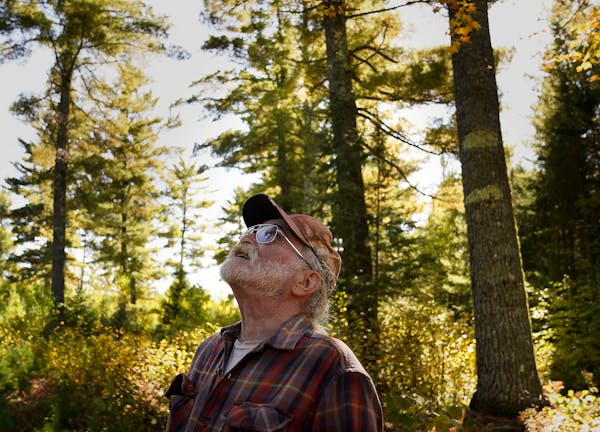The U.S. Fish and Wildlife Service will help train Department of Natural Resources (DNR) employees and monitor the agency's forest management to address long-simmering conflict over logging on state hunting lands acquired with millions of dollars in federal aid, according an agreement announced Thursday.
Fish and Wildlife Service Regional Director Charlie Wooley and DNR Commissioner Sarah Strommen told the Star Tribune that they struck a five-point management agreement this week. They described it as a collaborative path forward from discord over a major change in DNR logging called the Sustainable Timber Harvest Initiative.
The Star Tribune reported on the expanded logging program and related conflicts in late October.
The stepped-up logging program grew from a request by the state's forest products industry for DNR to expand timber offerings. In July 2019, not long after the computer-based plan kicked in, 28 DNR wildlife managers openly ripped it as an unlawful sellout to an industry that was harmful to wildlife habitat and wasteful of dollars collected from the sporting public. Their boss, DNR Fish and Wildlife Division Director Dave Olfelt, has continued to defend the new timber program, saying it doesn't sacrifice wildlife habitat for cordage targets.
Some of the rank-and-file complaints were validated eight months later when two federal wildlife biologists in Wooley's administration monitored logging activity at three of Minnesota's largest wildlife management areas (WMAs). According to a central finding in their report, DNR's Forestry Division appeared to be implementing timber harvests "primarily to meet commercial timber objectives.'' The report said DNR's Fish and Wildlife Division seemed to have little oversight of the cuttings despite legal requirements for any type of forest management on the wildlife lands to primarily benefit wildlife.
"Ultimately, it appears that Forestry controls forest management and timber sales on these WMAs,'' the report said.
The monitoring report said DNR "might lack compliance'' with seven laws and regulations, including the federal Pittman-Robertson Wildlife Restoration Act that provides millions of dollars annually to the DNR to acquire and manage public hunting lands. Instead of enhancing wildlife habitat, some of the observed sites were logged to the detriment of critters and hunters, the report said.
Wooley said DNR is not penalized under the new agreement, nor does the pact require the DNR to lower the cordage goals managed by its Forestry Division. Rather, he and Strommen said terms of the agreement are intended to reaffirm and emphasize how logging and other forest management practices must be carried out to achieve wildlife-first tenets inherent in accepting federal aid.
As of 2020, payments to the DNR under the federal program have ranged as high as $24 million in one year, including money for nonforested wildlife areas. Some of the money pays DNR salaries. The funds derive from hunting and fishing license sales as well as federal excise tax on hunting and fishing gear excise tax paid by hunters and anglers on gear they use.
"This is to unite us and focus on a game plan to move forward,'' Wooley said. He described the deal as "positive action to conduct this program the way it's supposed to be conducted.''
Before the Sustainable Timber Harvest Initiative, DNR wildlife managers could block or defer cuttings they viewed as detrimental to wildlife. The new management agreement doesn't restore that authority.
Strommen said cordage goals and other aspects of the Sustainable Timber Harvest Initiative will be up for review in 2023, the midpoint of the 10-year plan. She also acknowledged that her agency is years late on the delivery of grant-funded writing of master plans for "major unit" WMAs. One of the five terms of the new agreement with the Fish and Wildlife Service is to complete the plans under new deadlines and develop a systematic framework for the management of the remaining WMAs.
Other terms of the agreement include:
- The Fish and Wildlife Service and DNR will jointly develop field monitoring visits to assess logging and other forest management activities to assure they achieve goals and comply with federal grant program requirements. The two agencies will jointly conduct the monitoring "in a way that promotes communication, learning and transparency.''
- The two agencies will provide jointly led training for DNR employees in three divisions: Fish and Wildlife, Forestry, and Ecological and Water Resources. The training is to provide, among other things, specific requirements that need to be followed under federal aid programs.
- The DNR will finalize a document that clarifies staff roles in conducting forest habitat management activities on WMAs and Aquatic Management Areas.
- Strommen and Olfelt will write to DNR staff "reaffirming agency direction and commitment'' to forest habitat management on state lands. The message also will reaffirm the DNR's commitment to the requirements of federal aid programs and to unit-level planning.

Lynx improve to 7-0 with strong second half vs. expansion Valkyries

Twins lose in walk-off against Seattle for second straight game
Three-goal outburst in second half helps Minnesota United to rare victory in Seattle

Paddack happily surprised Twins gave him opportunity to finish eight innings

